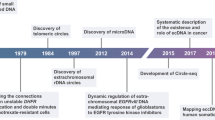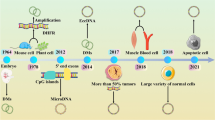Abstract.
Extrachromosomal circular DNA molecules are prevalent in cancer cells and harbor amplified genes, such as oncogenes and drug resistance genes, that can provide a selective growth advantage to cancer cells. These circular DNA structures include double minute chromosomes (dmin), which can be detected with light microscopy following Giemsa staining, and submicroscopic circular DNA structures referred to as episomes. In this study, we investigated the fate of dmin and episomes in multidrug-resistant human epidermoid KB-V1 cells undergoing cisplatin-induced apoptosis – a mode of cell death initially characterized by the fragmentation of chromosomal DNA, while the nuclear membrane remains intact. The circular DNA structures carry amplified copies of the multidrug resistance gene (MDR1). During cisplatin-induced apoptotic cell death, episomes and dmin, as well as native chromosomes, were degraded into high molecular weight DNA fragments of approximately 50 kb in length. DNA fragments in this size range appear to result from the preferential cleavage of matrix-associated regions in chromatin with the subsequent release of 20–30 nm loop domains of chromatin from the nuclear scaffold. Scanning electron microscopy studies were performed and confirmed the presence of 30 nm filaments in a higher-order DNA packing of MDR1-containing dmin and episomes. These combined data provide strong evidence that the higher-order DNA packing of episomes, as well as dmin, is similar to that of native chromosomes and underscore the potential for extrachromosomal DNA amplicons to study the structural and functional organization of chromatin. We discuss the implications of extrachromosomal DNA matrix associated regions competing with native chromosomal DNA for binding to the nuclear matrix in tumor cells.
Similar content being viewed by others
Author information
Authors and Affiliations
Additional information
Received: 18 August 1998; in revised form: 6 December 1998 / Accepted: 21 January 1999
Rights and permissions
About this article
Cite this article
Schoenlein, P., Barrett, J. & Welter, D. The degradation profile of extrachromosomal circular DNA during cisplatin-induced apoptosis is consistent with preferential cleavage at matrix attachment regions. Chromosoma 108, 121–131 (1999). https://doi.org/10.1007/s004120050359
Issue Date:
DOI: https://doi.org/10.1007/s004120050359




